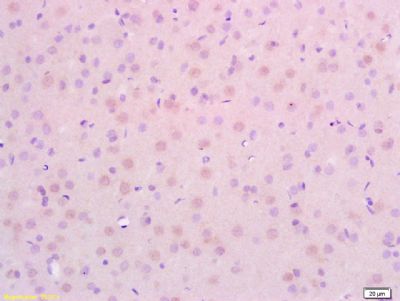CDKN2A/p14ARF,抑癌基因p14抗体
产品名称: CDKN2A/p14ARF,抑癌基因p14抗体
英文名称: Anti-CDKN2A/p14ARF antibody
产品编号: HZ-1174R
产品价格: null
产品产地: 中国/美国
品牌商标: HZbscience
更新时间: 2023-08-17T10:24:20
使用范围: WB,ELISA,IHC-P,IHC-F,IF
- 联系人 : 鲍丽雯
- 地址 : 上海市闵行区闵北路88弄1-30号第22幢AQ136室
- 邮编 : 200612
- 所在区域 : 上海
- 电话 : 139****0749
- 传真 : 021-60345367
- 邮箱 : www.shzbio.net
CDKN2A/p14ARF,抑癌基因p14抗体
产品编号HZ-1174R
英文名称CDKN2A/p14ARF
中文名称抑癌基因p14抗体
别 名CD2A2_HUMAN; p14 ARF; TP16; p16; CDKN2; MTS1; INK4a; CMM2; MLM; ARF; p16INK4a; INK4; p16-INK4a; p14; p16-INK4; p16INK4A; p16INK4; p19; p19ARF; CDK4I; MTS-1.
说 明 书0.1ml 0.2ml
研究领域肿瘤 细胞生物 神经生物学 信号转导 细胞凋亡 细胞周期蛋白
抗体来源Rabbit
克隆类型Polyclonal
交叉反应Mouse, Rat,
CDKN2A/p14ARF,抑癌基因p14抗体产品应用ELISA=1:500-1000 IHC-P=1:100-500 IHC-F=1:100-500 Flow-Cyt=1:20-200 IF=1:100-500 (石蜡切片需做抗原修复)
not yet tested in other applications.
optimal dilutions/concentrations should be determined by the end user.
分 子 量19kDa
性 状Lyophilized or Liquid
浓 度1mg/1ml
免 疫 原KLH conjugated synthetic peptide derived from human CDKN2A/p14ARF
亚 型IgG
纯化方法affinity purified by Protein A
储 存 液0.01M TBS(pH7.4) with 1% BSA, 0.03% Proclin300 and 50% Glycerol.
保存条件Store at -20 °C for one year. Avoid repeated freeze/thaw cycles. The lyophilized antibody is stable at room temperature for at least one month and for greater than a year when kept at -20°C. When reconstituted in sterile pH 7.4 0.01M PBS or diluent of antibody the antibody is stable for at least two weeks at 2-4 °C.
CDKN2A/p14ARF,抑癌基因p14抗体PubMedPubMed
产品介绍background:
This gene generates several transcript variants which differ in their first exons. At least three alternatively spliced variants encoding distinct proteins have been reported, two of which encode structurally related isoforms known to function as inhibitors of CDK4 kinase. The remaining transcript includes an alternate first exon located 20 Kb upstream of the remainder of the gene; this transcript contains an alternate open reading frame (ARF) that specifies a protein which is structurally unrelated to the products of the other variants. This ARF product functions as a stabilizer of the tumor suppressor protein p53 as it can interact with, and sequester, MDM1, a protein responsible for the degradation of p53. In spite of the structural and functional differences, the CDK inhibitor isoforms and the ARF product encoded by this gene, through the regulatory roles of CDK4 and p53 in cell cycle G1 progression, share a common functionality in cell cycle G1 control. This gene is frequently mutated or deleted in a wide variety of tumors, and is known to be an important tumor suppressor gene. CDKN2A.
Function:
Capable of inducing cell cycle arrest in G1 and G2 phases. Acts as a tumor suppressor. Binds to MDM2 and blocks its nucleocytoplasmic shuttling by sequestering it in the nucleolus. This inhibits the oncogenic action of MDM2 by blocking MDM2-induced degradation of p53 and enhancing p53-dependent transactivation and apoptosis. Also induces G2 arrest and apoptosis in a p53-independent manner by preventing the activation of cyclin B1/CDC2 complexes. Binds to BCL6 and down-regulates BCL6-induced transcriptional repression. Binds to E2F1 and MYC and blocks their transcriptional activator activity but has no effect on MYC transcriptional repression. Binds to TOP1/TOPOI and stimulates its activity. This complex binds to rRNA gene promoters and may play a role in rRNA transcription and/or maturation. Interacts with NPM1/B23 and promotes its polyubiquitination and degradation, thus inhibiting rRNA processing. Interacts with COMMD1 and promotes its 'Lys63'-linked polyubiquitination. Interacts with UBE2I/UBC9 and enhances sumoylation of a number of its binding partners including MDM2 and E2F1. Binds to HUWE1 and represses its ubiquitin ligase activity. May play a role in controlling cell proliferation and apoptosis during mammary gland development.
CDKN2A/p14ARF,抑癌基因p14抗体Subunit:
Does not interact with cyclins, CDK1, CDK2, CDK4, CDK5 or CDK6. Binds to BCL6, E2F1, HUWE1, MDM2, MYC, NPM1/B23, TOP1/TOPOI and UBE2I/UBC9. Interacts with TBRG1 and COMMD1. Interacts with CDKN2AIP and E4F1.
Subcellular Location:
Nucleus, nucleolus. Nucleus, nucleoplasm.
Post-translational modifications:
Ubiquitinated in normal cells by TRIP12 via the ubiquitin fusion degradation (UFD) pathway, a process that mediates ubiquitination at the N-terminus, regardeless of the absence of lysine residues. Ubiquitination leads to its degradation. In cancer cells, however, TRIP12 is located in a different cell compartment, preventing ubiquitination and degradation.
Gene ID:
1029
Database links:
Entrez Gene: 1029 Human
Omim: 600160 Human
SwissProt: P42771 Human
SwissProt: Q8N726 Human
Unigene: 512599 Human
Important Note:
This product as supplied is intended for research use only, not for use in human, therapeutic or diagnostic applications.
p14ARF是近年来发现的一种重要的抑癌基因,与细胞周期和凋亡的调控密切相关,p14ARF基因是细胞周期调控基因,它主要阻滞细胞于G1期和G2/M期,因此p14ARF与癌细胞的增殖和凋亡密切相关,在肿瘤的发生和演化中起着重要的作用。
p14ARF主要定位于细胞核,但也有部分定位于胞浆,与细胞周期有关。

